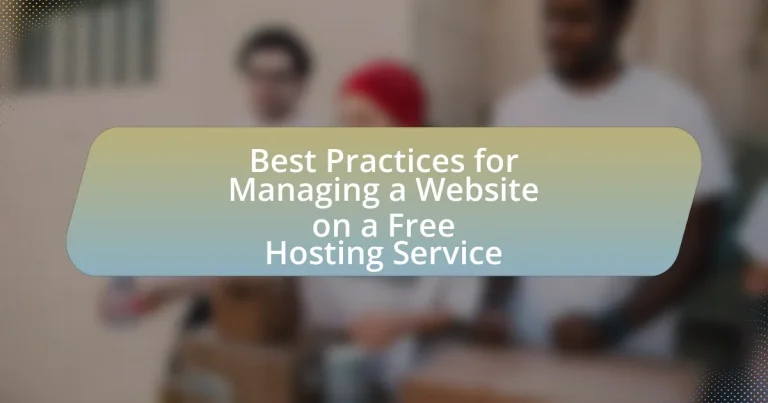The article focuses on best practices for managing a website hosted on a free hosting service. It covers essential strategies such as regular data backups, performance optimization, and security measures to enhance website functionality and user trust. Additionally, it provides guidance on selecting a reliable free hosting provider, understanding the limitations of such services, and optimizing website performance despite these constraints. The article also discusses content management, audience engagement, and troubleshooting common issues, ensuring that users can effectively maintain their online presence within the limitations of free hosting platforms.

What are the Best Practices for Managing a Website on a Free Hosting Service?
The best practices for managing a website on a free hosting service include regularly backing up your data, optimizing website performance, and ensuring security measures are in place. Regular backups protect against data loss, as free hosting services may not provide reliable recovery options. Optimizing performance, such as minimizing image sizes and using efficient coding, enhances user experience and can improve loading times, which is crucial since studies show that a one-second delay can lead to a 7% reduction in conversions. Implementing security measures, like using strong passwords and keeping software updated, is essential because free hosting services can be more vulnerable to attacks. These practices help maintain website functionality and user trust, which are vital for any online presence.
How can you effectively choose a free hosting service?
To effectively choose a free hosting service, evaluate the provider’s reliability, features, and limitations. Reliable providers often have a good uptime record, which is essential for website accessibility; for instance, a service with at least 99.9% uptime is generally considered dependable. Additionally, assess the features offered, such as storage space, bandwidth, and support for programming languages, as these directly impact your website’s performance. Limitations, including ads on your site, restricted storage, or lack of customer support, can hinder your website’s growth. Research user reviews and comparisons to validate the service’s reputation and performance, ensuring it aligns with your website’s needs.
What factors should you consider when selecting a free hosting provider?
When selecting a free hosting provider, consider factors such as storage space, bandwidth limits, uptime reliability, customer support, and the presence of ads. Storage space and bandwidth directly affect your website’s performance; for instance, providers like InfinityFree offer unlimited storage, while others may impose strict limits. Uptime reliability is crucial, as a provider with a 99.9% uptime guarantee ensures your site remains accessible, which is supported by data from industry reports indicating that downtime can significantly impact user experience and SEO rankings. Customer support is essential, especially for beginners, as responsive support can help resolve issues quickly; providers like 000webhost offer community forums and email support. Lastly, the presence of ads can detract from your site’s professionalism; some free hosts, like WordPress.com, display ads, while others, like GitHub Pages, do not.
How do the features of free hosting services vary?
The features of free hosting services vary significantly in terms of storage space, bandwidth, customer support, and advertising policies. For instance, some free hosting providers offer limited storage (as low as 500 MB) and bandwidth (around 1 GB per month), while others may provide more generous limits, such as 5 GB of storage and unlimited bandwidth. Additionally, customer support can range from minimal assistance through forums to more comprehensive support via live chat or email. Furthermore, many free hosting services impose mandatory advertisements on user websites, whereas a few allow users to have ad-free experiences. These variations are crucial for users to consider when selecting a free hosting service that meets their specific needs.
What are the common limitations of free hosting services?
Common limitations of free hosting services include restricted storage space, limited bandwidth, lack of customer support, and the presence of advertisements. These services often provide minimal resources, which can hinder website performance and scalability. For instance, many free hosting platforms offer only a few hundred megabytes of storage, which is insufficient for larger websites. Additionally, bandwidth limitations can lead to slow loading times or downtime during traffic spikes. The absence of reliable customer support means users may struggle to resolve issues promptly. Furthermore, free hosting services typically display ads on users’ websites, which can detract from the user experience and professional appearance.
How do bandwidth and storage limitations affect website performance?
Bandwidth and storage limitations significantly hinder website performance by restricting data transfer rates and available space for content. When bandwidth is low, users experience slower loading times, as the server cannot transmit data quickly enough to meet demand, leading to increased bounce rates. For instance, a study by Google found that a one-second delay in loading time can reduce conversions by 20%. Similarly, limited storage restricts the amount of content and media that can be hosted, which can lead to incomplete or outdated information being presented to users. This limitation can also prevent the implementation of essential features, such as high-resolution images or videos, further degrading user experience. Therefore, both bandwidth and storage constraints directly correlate with slower performance and reduced user satisfaction on websites.
What are the implications of having ads on your free website?
Having ads on your free website can lead to both monetization opportunities and potential drawbacks such as user experience issues. The presence of ads allows website owners to generate revenue without incurring hosting costs, which is particularly beneficial for those on a tight budget. However, excessive or intrusive advertisements can detract from the user experience, leading to higher bounce rates and lower engagement. According to a study by the Nielsen Norman Group, users often find ads distracting, which can negatively impact their perception of the website’s credibility. Therefore, while ads can provide financial benefits, they must be managed carefully to maintain a positive user experience.
How can you optimize your website for better performance on a free hosting service?
To optimize your website for better performance on a free hosting service, focus on minimizing file sizes and leveraging caching techniques. Reducing image sizes through compression tools like TinyPNG can significantly decrease load times, as images often account for a large portion of page weight. Implementing browser caching allows returning visitors to load your site faster by storing static resources locally, which is crucial on limited bandwidth free hosting. Additionally, using a Content Delivery Network (CDN) can enhance loading speeds by distributing content across multiple servers, reducing latency. According to studies, websites that utilize these optimization techniques can see performance improvements of up to 50%, making them essential for effective management on free hosting platforms.
What strategies can improve loading speed on a free hosting platform?
To improve loading speed on a free hosting platform, optimize images and leverage browser caching. Optimizing images involves compressing them to reduce file size without sacrificing quality, which can significantly decrease load times. For instance, using formats like WebP can reduce image sizes by up to 30% compared to traditional formats like JPEG or PNG. Leveraging browser caching allows frequently accessed resources to be stored locally on users’ devices, reducing the need to fetch them from the server repeatedly. This can lead to faster load times, as studies show that caching can improve page load speed by up to 50%.
How can you enhance user experience despite hosting limitations?
To enhance user experience despite hosting limitations, optimize website performance through efficient coding and resource management. Implementing techniques such as image compression, minifying CSS and JavaScript, and utilizing browser caching can significantly reduce load times, which is crucial since free hosting services often have slower response rates. According to Google, a one-second delay in mobile load times can lead to a 20% decrease in conversions, highlighting the importance of speed in user experience. Additionally, using a Content Delivery Network (CDN) can help distribute content more effectively, improving access speed for users across different geographical locations.

What security measures should you implement on a free hosting service?
To enhance security on a free hosting service, implement measures such as using strong, unique passwords, enabling two-factor authentication, and regularly updating software. Strong passwords reduce the risk of unauthorized access, while two-factor authentication adds an additional layer of security, making it harder for attackers to gain entry. Regular software updates patch vulnerabilities, which is crucial since free hosting services may not provide robust security features. According to a study by the Cybersecurity & Infrastructure Security Agency, 85% of breaches involve weak or stolen credentials, highlighting the importance of these security practices.
How can you protect your website from common threats?
To protect your website from common threats, implement strong security measures such as using HTTPS, regularly updating software, and employing firewalls. HTTPS encrypts data transmitted between the user and the server, reducing the risk of interception. Regular software updates patch vulnerabilities that could be exploited by attackers, while firewalls monitor and control incoming and outgoing network traffic based on predetermined security rules, effectively blocking malicious access. According to a report by the Cybersecurity & Infrastructure Security Agency, 60% of data breaches are linked to unpatched vulnerabilities, highlighting the importance of these protective measures.
What are the best practices for securing your website data?
The best practices for securing your website data include implementing HTTPS, using strong passwords, regularly updating software, and employing security plugins. HTTPS encrypts data transmitted between the user and the server, protecting sensitive information from interception. Strong passwords, ideally a mix of letters, numbers, and symbols, reduce the risk of unauthorized access; studies show that 81% of data breaches are linked to weak passwords. Regular software updates patch vulnerabilities, as 60% of breaches exploit known vulnerabilities. Security plugins can provide additional layers of protection, such as firewalls and malware scanning, which are essential for maintaining website integrity.
How can you ensure regular backups of your website content?
To ensure regular backups of your website content, implement an automated backup solution that schedules backups at defined intervals. Many content management systems (CMS) offer plugins or built-in features that allow you to set up automatic backups, ensuring that your data is consistently saved without manual intervention. For instance, WordPress users can utilize plugins like UpdraftPlus or BackupBuddy, which can automatically back up files and databases to cloud storage services such as Google Drive or Dropbox. This method not only simplifies the backup process but also provides a reliable way to restore your website in case of data loss, as evidenced by the fact that automated backups can reduce the risk of losing critical content by up to 90%.
What role does SSL play in securing your free website?
SSL, or Secure Sockets Layer, plays a critical role in securing your free website by encrypting data transmitted between the user’s browser and the web server. This encryption protects sensitive information, such as login credentials and personal data, from being intercepted by malicious actors during transmission. According to a study by Google, websites using SSL are perceived as more trustworthy by users, which can lead to increased engagement and lower bounce rates. Furthermore, major web browsers, like Chrome and Firefox, flag non-SSL sites as “Not Secure,” which can deter visitors and negatively impact your website’s credibility. Thus, implementing SSL is essential for maintaining user trust and safeguarding data on a free website.
How can you obtain an SSL certificate for a free hosting service?
To obtain an SSL certificate for a free hosting service, you can use services like Let’s Encrypt, which provides free SSL certificates. Many free hosting providers support Let’s Encrypt integration, allowing you to easily generate and install the certificate through their control panel. This process typically involves verifying your domain ownership and following the provider’s specific instructions for SSL installation. Let’s Encrypt is widely recognized and trusted, making it a valid option for securing your website on a free hosting platform.
What are the benefits of using SSL for your website?
Using SSL for your website enhances security, builds trust, and improves SEO rankings. SSL encrypts data transmitted between the user’s browser and the server, protecting sensitive information from interception. According to a 2021 study by Google, websites with SSL certificates are favored in search engine rankings, leading to increased visibility. Additionally, displaying the padlock symbol in the browser instills confidence in users, which can lead to higher conversion rates.

How can you effectively manage content on a free hosting service?
To effectively manage content on a free hosting service, prioritize organization and regular updates. Organizing content into clear categories and using a consistent naming convention enhances navigation and user experience. Regularly updating content keeps the website relevant and engaging, which is crucial since free hosting services often have limitations on storage and bandwidth. Additionally, utilizing built-in tools for analytics can help track user engagement and identify popular content, allowing for informed decisions on what to promote or modify. These practices ensure that the website remains functional and appealing, even within the constraints of a free hosting environment.
What content management systems are compatible with free hosting services?
WordPress, Joomla, and Drupal are content management systems compatible with free hosting services. These platforms are widely used due to their flexibility and ease of installation on various free hosting providers. For instance, WordPress can be set up on free hosts like WordPress.com and InfinityFree, while Joomla and Drupal also offer installation options on similar platforms. Their compatibility with free hosting is supported by the availability of one-click installers and community support, making them accessible for users seeking to manage websites without incurring costs.
How do different CMS options impact website management?
Different CMS options significantly impact website management by influencing usability, customization, and scalability. For instance, platforms like WordPress offer extensive plugins and themes, enabling users to easily customize their sites without coding knowledge, which enhances management efficiency. In contrast, simpler CMS options may limit functionality, requiring more technical skills for advanced features, thus complicating management. Additionally, CMS choices affect content organization; systems like Joomla provide robust categorization tools, facilitating better content management. Research indicates that 43% of users prefer WordPress for its user-friendly interface and flexibility, demonstrating its effectiveness in streamlining website management tasks.
What are the pros and cons of using a CMS on a free hosting service?
Using a CMS on a free hosting service has both advantages and disadvantages. The pros include cost-effectiveness, as free hosting eliminates expenses associated with paid services, and ease of use, since many CMS platforms offer user-friendly interfaces that simplify website management for non-technical users. Additionally, free hosting services often provide built-in templates and plugins that enhance functionality without requiring extensive coding knowledge.
Conversely, the cons involve limited resources, as free hosting typically offers less storage and bandwidth, which can hinder website performance and scalability. Security is another concern; free hosting services may lack robust security measures, making websites more vulnerable to attacks. Furthermore, customization options can be restricted, limiting the ability to tailor the website to specific needs. Lastly, free hosting often includes advertisements, which can detract from the user experience and brand image.
How can you engage your audience through content on a free website?
To engage your audience through content on a free website, create high-quality, relevant, and interactive content that resonates with your target audience. Engaging content includes blog posts, videos, infographics, and interactive polls or quizzes that encourage user participation. According to a HubSpot report, 70% of marketers actively invest in content marketing, highlighting its effectiveness in audience engagement. Additionally, optimizing content for SEO can increase visibility, drawing more visitors to the site, which further enhances engagement opportunities.
What types of content are most effective for audience engagement?
Interactive content, such as quizzes, polls, and surveys, is most effective for audience engagement. This type of content actively involves users, encouraging participation and feedback, which can lead to higher retention rates. According to a study by Content Marketing Institute, interactive content generates twice the engagement of static content, making it a powerful tool for capturing audience interest and fostering community interaction.
How can you utilize social media to drive traffic to your free website?
Utilizing social media effectively can significantly drive traffic to your free website by creating engaging content and leveraging targeted advertising. Engaging content, such as informative posts, eye-catching images, and interactive polls, encourages users to share and visit your website. For instance, platforms like Facebook and Instagram have billions of active users, providing a vast audience for your content. Additionally, targeted advertising on these platforms allows you to reach specific demographics, increasing the likelihood of attracting visitors interested in your website’s niche. According to a report by Hootsuite, social media drives 31% of all referral traffic, highlighting its effectiveness in increasing website visits.
What are the best practices for troubleshooting common issues on a free hosting service?
The best practices for troubleshooting common issues on a free hosting service include checking server status, reviewing error logs, and ensuring proper configuration settings. First, users should verify if the hosting service is experiencing downtime by checking their status page or using third-party monitoring tools. Next, examining error logs can provide insights into specific issues, such as file permission errors or script failures. Additionally, confirming that configuration settings, such as database connections and file paths, are correct is crucial for resolving functionality problems. These practices are effective because they address the most frequent causes of issues, allowing users to quickly identify and rectify problems.
How can you identify and resolve performance issues quickly?
To identify and resolve performance issues quickly, utilize monitoring tools to analyze website metrics such as load times, server response times, and user interactions. These tools, like Google PageSpeed Insights or GTmetrix, provide actionable insights that highlight specific areas needing improvement. For instance, if load times exceed three seconds, optimizing images and leveraging browser caching can significantly enhance performance. Additionally, regularly reviewing server logs can reveal bottlenecks or errors that may affect site speed. Implementing these strategies allows for rapid identification and resolution of performance issues, ensuring a smoother user experience.
What resources are available for troubleshooting website problems?
Resources available for troubleshooting website problems include online forums, documentation from hosting providers, and troubleshooting tools. Online forums such as Stack Overflow and Reddit provide community support where users can ask questions and share solutions. Documentation from hosting providers often includes FAQs and troubleshooting guides specific to their services, which can help identify common issues. Additionally, tools like Google PageSpeed Insights and GTmetrix offer performance analysis and can pinpoint problems affecting website functionality. These resources are widely recognized for their effectiveness in resolving website issues.





